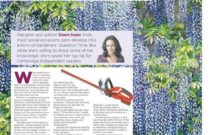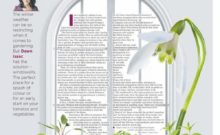You might have already noticed that I am a ‘just in time’ kind of gardener. I like this term. It sounds more like a streamlined process that avoids waste rather than what it really is: me on the verge of being late for everything.
This month is no exception as I am currently rushing through orders for bare rooted plants. I’m sure the erudite readers of the Cambridge Independent know exactly what ‘bare rooted’ plants are but just in case you want to test me, these are plants sent out in their dormant winter state with no soil around their roots. They’re easier and cheaper to ship, are usually less pricey as a result and, best of all in my opinion, tend to establish better when they’re planted.
The trouble is, unlike plants in containers, these aren’t available all year round. Obviously, they wake up when spring has sprung and need to be somewhere other than in a giant jiffy bag so the clock is ticking. Thankfully I just about have time to get in my orders – which is lucky as a couple of community orchards are banking on it.
You see fruit trees are perfect bare rooted candidates. Although you can often find a decent selection of container grown trees at your local garden centre, the range really opens up when you can have them posted to you in bare root form. My own order is with a charity based in Norfolk: The East of England Apples and Orchards Project or EEAOP (www.applesandorchards.org.uk). This is a not-for-profit company that specialises in preserving some of the varieties of apple, plum, pear and cherry trees local to the seven counties in the area – including Cambridgeshire.
It’s an initiative I love on many levels. First it’s saving heritage fruit trees that otherwise might disappear. As our taste buds are reconditioned to the universal sweetness of Pink Lady or the ubiquitous Victoria plums, we are in danger of missing out on a fruit smorgasbord that offers far more variety and interest.
And from a growing perspective, why not choose trees that you know have thrived in your part of the country for years; the ones that not only tolerate our drier conditions and particular soil types, but actually welcome them?
And then of course there are the names. There is nothing more splendid than baking a Cottenham Seedling, stewing a Jolly Miller, or nibbling on a Thoday’s Quarrenden. And for anyone harbouring anti-aristocratic tendencies, you could even slice up Lady Hollendale or Lord Peckover for tea.
Of course, we won’t be in apple-picking mode for a few years. Most of the plants I’m ordering will be 1 year old whips (long sticks with roots to the untrained eye) but that’s part of the magic of these orchards. We will ahve children from Crosshall Junior School planting these out one year and then watching as they grow from season to season. Within a few short years, with some care and pruning by the students themselves, we will be able to have Apple Days just like the EEAOP have themselves.
The second orchard will be in my own village – on a piece of land which was once the cemetery behind the long-since demolished Baptist Chapel but that still serves as a Garden of Rest. The local community will be planting and caring for the trees – and hopefully enjoying the produce in years to come. Just as long as I remember to get this order in of course…






